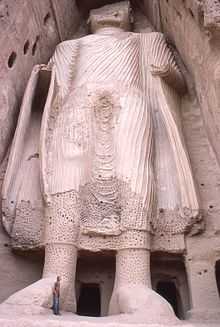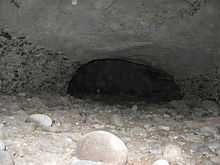Buddhism in Afghanistan


Buddhism was one of the major religions in Afghanistan during pre-Islamic era. The religion was widespread south of the Hindu Kush mountains. Buddhism first arrived in Afghanistan in 305 BCE when the Greek Seleucid Empire made an alliance with the Indian Maurya Empire. The resulting Greco-Buddhism flourished under the Greco-Bactrian Kingdom (250 BC-125 BC) and the later Indo-Greek Kingdom (180 BC - 10 CE) in modern northern Pakistan and Afghanistan. Greco-Buddhism reached its height under the Kushan Empire, which used the Greek alphabet to write its Bactrian language.
Numerous Buddhist monks were sent out, including Bodhidharma the founder of Zen Buddhism in China and legendary founder of Shaolin Kung Fu, Lokaksema (c. 178 CE), who travelled to the Chinese capital of Loyang and was the first translator of Mahayana Buddhist scriptures into Chinese,[1] and Mahadharmaraksita who, according to the Mahavamsa (Chap. XXIX[2]), led 30,000 Buddhist monks from "the Greek city of Alasandra" (Alexandria of the Caucasus, around 150 km north of today's Kabul in Afghanistan), to Sri Lanka for the dedication of the Great Stupa in Anuradhapura. The Greco-Bactrian King Menander I, (Pali) "Milinda," ruled (165 BC - 135 BC) was a renowned patron of Buddhism immortalized in the Buddhist text the Milinda Panha.
The religion started fading with the arrival of Islam in the 7th century but finally ended during the Ghaznavids in the 11th century.[3]
History
The territory within the borders of Afghanistan has seen many cultural and religious shifts over the centuries. The geographical position of the area between the Middle East, South Asian, and Central Asian cultures, and the proximity to the famous Silk Road (connecting East Asian and Mediterranean civilizations, and others in between), have been major drivers of local historical and cultural developments. One major influence was the conquest of the area by Alexander the Great, which incorporated the area for a time into the Hellenistic World, and resulted in a strong Hellenistic influence on Buddhist religious art. In 305 BCE, the Seleucid Empire made an alliance with the Indian Maurya Empire. The Mauryans brought Buddhism from India and controlled the area south of the Hindu Kush until about 185 BCE when they were overthrown.
Alexander took these away from the Aryans and established settlements of his own, but Seleucus Nicator gave them to Sandrocottus (Chandragupta), upon terms of intermarriage and of receiving in exchange 500 elephants.[4]
At the time of these developments, most of the area belonged to the kingdoms of Bactria and Sogdiana. Many of the Iranian forebearers of the Pashtuns, including the Scythians, followed Buddhism until the arrival of Islam.
Many monuments testify to the Buddhist culture in present-day Afghanistan. Greek cultural and artistic influence in the region can be researched under Buddhist art and Greco-Buddhism. Additional historical detail can be researched under Pre Islamic Hindu and Buddhist heritage of Afghanistan and Hinduism in Afghanistan.
The Buddhist religion survived the Islamic conquest of Afghanistan by the Umayyads and rule by the Abbasid Caliphate. Buddhism in Afghanistan was extinguished by the Saffarids, Ghaznavids, and Ghurids.[5][6]
Archaeological finds
Bamiyan monastery library
One of the early Buddhist schools, the Mahāsāṃghika-Lokottaravāda, were known to be prominent in the area of Bamiyan. The Chinese Buddhist monk Xuanzang visited a Lokottaravāda monastery in the 7th century CE, at Bamiyan, Afghanistan, and this monastery site has since been rediscovered by archaeologists.[7] Birchbark and palm leaf manuscripts of texts in this monastery's collection, including Mahāyāna sūtras, have been discovered at the site, and these are now located in the Schøyen Collection. Some manuscripts are in the Gāndhārī language and Kharoṣṭhī script, while others are in Sanskrit and written in forms of the Gupta script. Manuscripts and fragments that have survived from this monastery's collection include the following source texts:[7]
- Pratimokṣa Vibhaṅga of the Mahāsāṃghika-Lokottaravāda (MS 2382/269)
- Mahāparinirvāṇa Sūtra, a sūtra from the Āgamas (MS 2179/44)
- Caṃgī Sūtra, a sūtra from the Āgamas (MS 2376)
- Vajracchedikā Prajñāpāramitā Sūtra, a Mahāyāna sūtra (MS 2385)
- Bhaiṣajyaguru Sūtra, a Mahāyāna sūtra (MS 2385)
- Śrīmālādevī Siṃhanāda Sūtra, a Mahāyāna sūtra (MS 2378)
- Pravāraṇa Sūtra, a Mahāyāna sūtra (MS 2378)
- Sarvadharmapravṛttinirdeśa Sūtra, a Mahāyāna sūtra (MS 2378)
- Ajātaśatrukaukṛtyavinodana Sūtra, a Mahāyāna sūtra (MS 2378)
- Śāriputra Abhidharma Śāstra (MS 2375/08)
Buddhist relics
In August 2010, it was reported that approximately 42 Buddhist relics have been discovered in the Logar Province of Afghanistan, which is south of Kabul. Some of these items date back to the 2nd century according to Archaeologists. Some Buddhist sites were found in Ghazni.[8] The items in Logar include two Buddhist temples (Stupas), Buddha statues, frescos, silver and gold coins and precious beads.[9][10][11]
There is a temple, stupas, beautiful rooms, big and small statues, two with the length of seven and nine meters, colorful frescos ornamented with gold and some coins... Some of the relics date back to the fifth century (AD)... We have come across signs that there are items maybe going back to the era before Christ or prehistory... We need foreign assistance to preserve these and their expertise to help us with further excavations.[12]—Mohammad Nader Rasouli, Afghan Archaeological Department
See also
- Buddhism in Pakistan
- Buddhism in Iran
- Pre-Islamic Hindu and Buddhist heritage of Afghanistan
- Silk Road transmission of Buddhism
- Trapusa and Bahalika
References
- ↑ Foltz, Religions of the Silk Road, p. 46
- ↑ Full text of the Mahavamsa Click chapter XXIX
- ↑ Berzin, Alexander (December 2006). "Historical Sketch of Buddhism and Islam in Afghanistan". Retrieved November 2, 2010.
- ↑ Nancy Hatch Dupree / Aḥmad ʻAlī Kuhzād (1972). "An Historical Guide to Kabul – The Name". American International School of Kabul. Retrieved September 18, 2010.
- ↑ Amy Romano (2003). A Historical Atlas of Afghanistan (illustrated ed.). The Rosen Publishing Group. p. 25. ISBN 0-8239-3863-8. Retrieved 18 September 2011.
- ↑ Steven Otfinoski (2004). Afghanistan (illustrated ed.). Infobase Publishing. p. 6. ISBN 0-8160-5056-2. Retrieved 18 September 2011.
- ↑ 7.0 7.1 "Schøyen Collection: Buddhism". Retrieved 23 June 2012.
- ↑ Embassy of the United States, Kabul. Ghazni 10.26.2011
- ↑ Embassy of the United States, Kabul. Mes Aynak 10.29.2011
- ↑ "42 Buddhist relics discovered in Logar". Maqsood Azizi. Pajhwok Afghan News. Aug 18, 2010. Retrieved 2010-08-23.
- ↑ "Afghan archaeologists find Buddhist site as war rages". Sayed Salahuddin. News Daily. Aug 17, 2010. Retrieved 2010-08-16.
- ↑ "Buddhist remains found in Afghanistan". Press TV. Aug 17, 2010. Retrieved 2010-08-16.
External links
| Wikimedia Commons has media related to Buddhism in Afghanistan. |
| ||||||||||||||